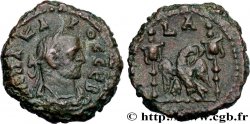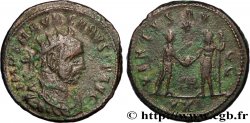E-auction 155-93116 - brm_308531 - CARUS Aurelianus
You must signin and be an approved bidder to bid, LOGIN TO BID. Accounts are subject to approval and the approval process takes place within 48 hours. Do not wait until the day a sale closes to register. Clicking on « bid » constitutes acceptance of the terms of use of cgb.fr private e-auctions.
Bids must be placed in whole Euro amounts only. The sale will start closing at the time stated on the item description; any bids received at the site after the closing time will not be executed. Transmission times may vary and bids could be rejected if you wait until the last second. For further information ckeck the E-auctions F.A.Q.
NO BUYER'S FEE.
NO BUYER'S FEE.
| Estimate : | 150 € |
| Price : | 48 € |
| Maximum bid : | 100 € |
| End of the sale : | 04 April 2016 14:45:30 |
| bidders : | 8 bidders |
Type : Aurelianus
Date: 282
Mint name / Town : Roma
Metal : billon
Millesimal fineness : 50 ‰
Diameter : 23 mm
Orientation dies : 6 h.
Weight : 5,99 g.
Officine: 2e
Coments on the condition:
Exemplaire sur un grand flan ovale bien centré des deux côtés avec les grènetis complets. Beau portrait de Carus à l’usure superficielle. Revers de style fin bien venu à la frappe. Patine marron glacé
Catalogue references :
Obverse
Obverse legend : IMP C M AVR CARVS P F AVG.
Obverse description : Buste radié et cuirassé de Carus à droite drapé sur l’épauleavec l’égide, vu de trois quarts en avant (B03).
Obverse translation : "Imperator Cæsar Marcus Aurelius Carus Pius Felix Augustus", (L’empereur césar Marc Aurèle Carus pieux heureux auguste).
Reverse
Reverse legend : IOVI - VI-CTORI/ -|-// BKA.
Reverse description : Jupiter, nu, le manteau sur l'épaule gauche, debout à gauche, tenant une victoriola de la main droite et de la gauche un sceptre long ; à ses pieds, un aigle à gauche tournant la tête à droite.
Reverse translation : "Iovi Victori", (À Jupiter victorieux).
Commentary
Poids extrêmement lourd. Sans argenture superficielle. Rubans de type 3 aux extrémités bouletées. Cuirasse et épaulière cloutées. Ptéryges larges. Grand pan de paludamentum et petite égide sur l’épaule.








 Report a mistake
Report a mistake Print the page
Print the page Share my selection
Share my selection Ask a question
Ask a question Consign / sell
Consign / sell
 Full data
Full data






